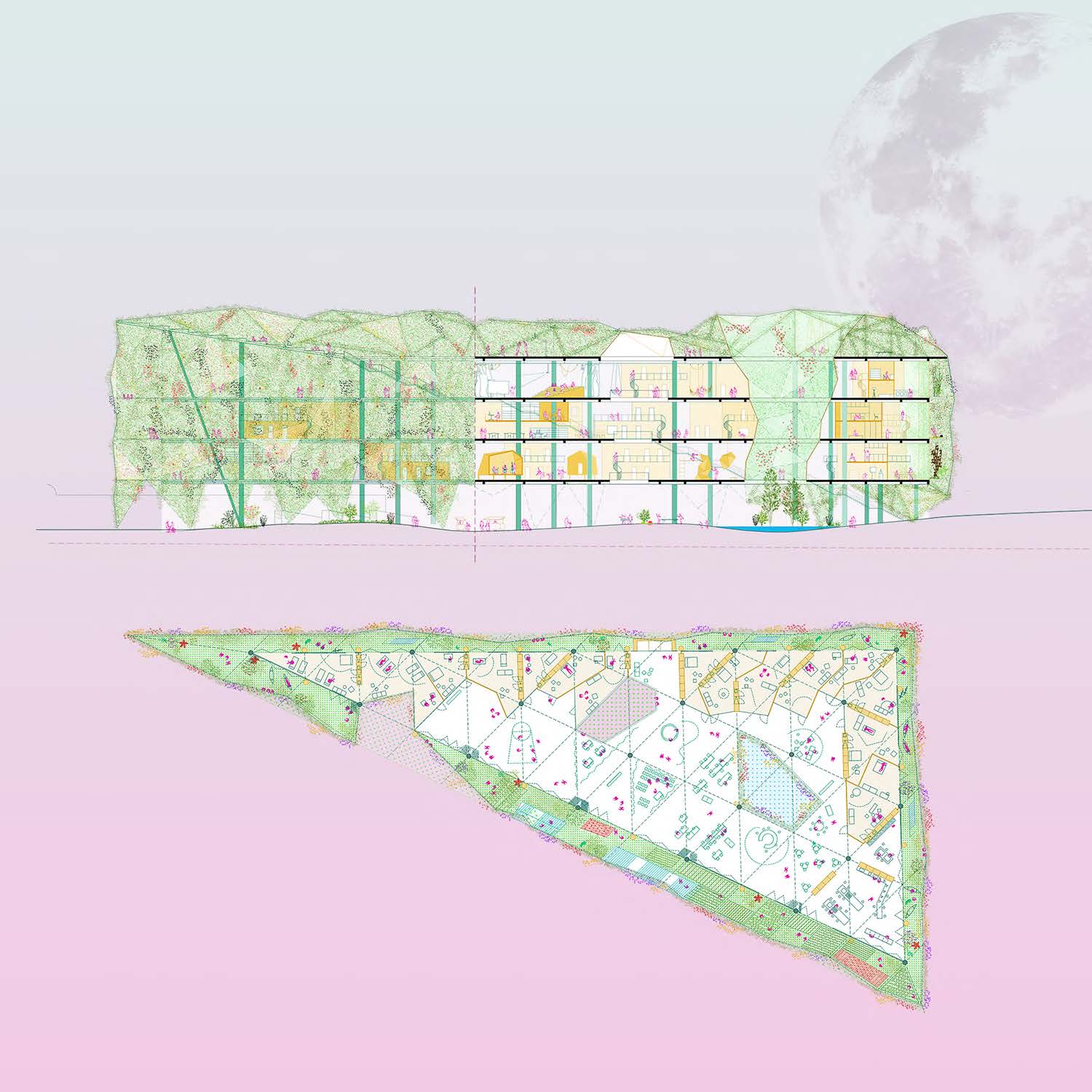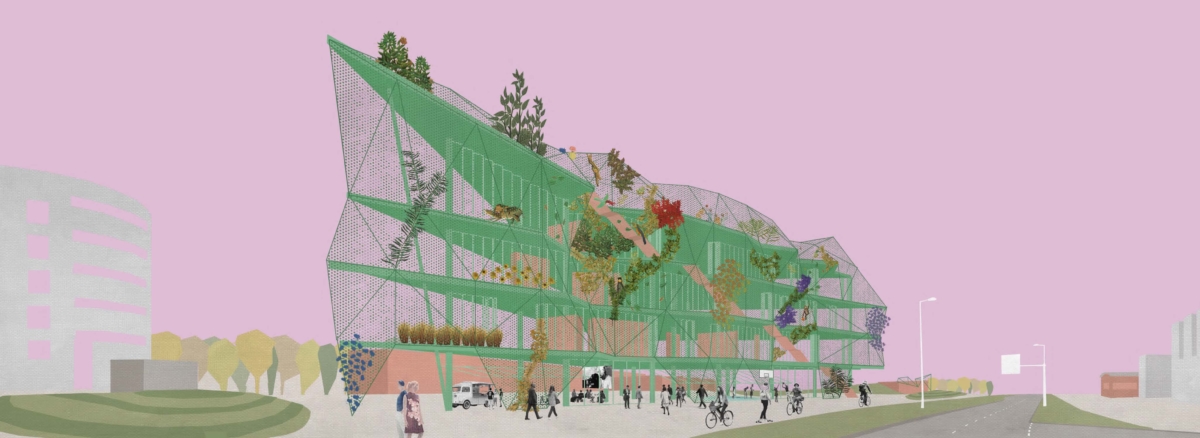Hybrid Parliament: The City That Cares

Hybrid Parliament
Render: Hybrid Parliament Team
The winning proposal for Rotterdam’s Europan 15 Kop Dakpark site, Hybrid Parliament, is a design solution that presents a sustainable, durable, social and ecological structure. It is a shelter for the hybridisation of all possible current and future human and non-human realities in the global metropolis of the 21st century. It is an architecture-manifesto for Rotterdam that supports a democratic, productive, inclusive, egalitarian, and horizontal community. It reproduces a parliamentary operation which addresses personal conflicts that invariably result from coexistence through speech and agreements among its parts.
Hybrid Parliament Team Interview
Videography: Kristel Kuiper; Interview: Cullo Studio for AIR
Key definitions to consider:
- hybrid = unconventional, anti-patriarchal, feminist, queer, anti-canonical
- parliament = democracy, horizontality, anti-authoritarianism, cooperation, agreement
Rotterdam as a city of infrastructure
Rotterdam is a city supported by large infrastructure: its harbour, polders, existing, and old railway routes, canals, bridges, locks, and highways. Paradoxically, this infrastructure which was designed to facilitate connection has become, in some places, a significant barrier, and often leaves neighbourhoods isolated, despite being in close proximity. This is the case with Kop DakPark and Marconiplein: as a result of its disconnection, Kop DakPark is a large, formless, empty void with few distinct urban qualities.
From vacant green space to an activated parklane
This design solution converts the large urban void of Kop DakPark – Marconiplein into a nexus at the local and larger urban scale. Its intervention connects the neighbourhoods and transforms what is currently a non-place into a new meeting space. Its new activities offer the means for new dynamics of social strengthening and exchange between neighbourhoods. These also facilitate a new metropolitan dynamics through the enhancement of the Parklane’s green continuum.
To achieve this goal, the following interventions are inserted:
- A “canopy” and greenery that enables CO2 capture, and facilitates the climate adaptation and transformation of the site.
- An urban lighting feature that evokes railway tracks, unveiling features of former use of the location which were erased during the construction of the retail park
- Health and social meeting spaces: playgrounds, open air sport facilities, physical shelters
- Integration of digital and physical facilities that support productivity: WiFi, urban gardens, equipped surfaces
- Optimisation of the public transport hub: metro, tramway, and bus access
- Activation of the large retail park with new economic activities, an enhancement of its facade, and the addition of cross-sectional terraces

Schematic Masterplan
Drawing: Hybrid Parliament Team
Where We Would Live Together
Hybrid Parliament: a boat, a park, a common house
“Hybrid Parliament” is a stranded ship, cast away from the nearby harbour. It signals the virtual continuity between Marconiplein and Kop Dakpark, with its bow, melted, and creating a large urban continuum. “Hybrid Parliament” is for humans and non-humans alike. Its continuous ground floor becomes a climate-controlled park, and its green, walkable façade grows from the park to facilitate a collective appropriation for both people and animals. It is a node of biological centrality in the era of the anthropocene.
As such, “Hybrid Parliament” should not be understood as a conventional building, but rather as a multiplication of the urban surface for, and by new ways of inhabiting, working and enjoying leisure activities in the 21st century. It is a building that must be understood as a juxtaposition of plans equipped, and thermally-controlled to densify the city and to offer a neutral shelter to support the life of all species.
“Hybrid Parliament” is a lighthouse, accommodating everything metropolitan. It is not just a productive building, but a building with a social and inclusive dimension where all are welcome.
“Hybrid Parliament” is an architectural manifesto of the Omgevingsvisie (productive, inclusive, circular, healthy and compact city). As a result, it is a repeatable system that can also be placed in other sites in Rotterdam. Performing as a manifesto of this vision, it is a prototype building that enhances the social resilience of Rotterdam, while also contributing to the comprehensive growth of the city.
Marconiplein and Kopdakpark merge inside Hybrid Parliament’s urban continuum
The building extends Marconiplein’s hub through its ground floor by creating a large public square. It also extends the park from the ground plane to its roof, through the great green staircase that rises in its façade, performing as a green vertical garden for social activation.
A permeable space between neighbourhoods
The surrounding neighbourhoods are specialized: living, working, leisure…. The building condenses all these functions at the same time under one single roof sheltering new society forms of the 21st century. Where before there was division due to lack of activity, now there is union through diversity. The ground floor is shaped with a new topography to allow the connection between the neighbourhoods.

Schematic Section
Drawing: Hybrid Parliament Team
Systemic building
“Hybrid Parliament” can grow in height and breadth adapting itself to the specificities of the site and program. The proposal reflects 100 living units for all kinds of occupants. It can expand according to these architectonic rules to reach a height of 50m (now 35m).
Ground Floor
Topography facilitates a continuity between the interior and exterior and creates areas where multiple activities can take place. The ground floor area is a large, equipped plane that supports multiple uses, and is a “climate-controlled park” drawing the building’s activities to the city. A tilting glass façade opens and closes according to these activities and the weather.
The building’s ground floor houses a large meeting point between neighbourhoods and is directly linked to Marconiplein’s public transport hub. Dakpark’s activities extend to the garden rooftop through a public staircase that climbs its green façade. This is a vertical park that wraps around a productive and inclusive core which supports inhabited platforms.
Structure: grid
A metal structure of pillars that support triangularized beams allows to cover the space with large spans. The height between floors is 6m to in-between levels.

Plan and Section
Drawing: Hybrid Parliament Team
Inhabiting platform: inclusion and productivity
“Hybrid Parliament” is a repetition of platforms that extend the urban surface through the building through multiple levels, and densify and further compact the city. These platforms are neutral, free spaces so that they can support all kinds of activities for all manner of life. Vertical circulation is located along the perimeter to maximise flexible space. Inside, two courtyards draw daylight in, and visually connect different platform levels.
Architecture for non-humans
The building skin becomes a space of coexistence for all species: plants, humans and animals. Production spots (hydroponics, orchards, greenhouses) alternate with nature sanctuaries (biotopes), not accessible to humans. This way, nature becomes a true part of the architecture.
Delights-deck
The construction of the building does not mean a loss of park surface area. Therefore, this design solution proposes a landscaped roof with a spatial equivalent to the footprint of the building. These topographies create spaces for socialization. The bow of Hybrid Parliament’s ship-like form, for example, becomes an outdoor auditorium.
Energy & water for a circular building
The building captures the energy of the sun through photovoltaic cells. Water is collected through a membrane and irrigates the façade. It is also collected on the ground floor, where it collects in a pool for recreation, and climate regulation.
Structure
The structure of pillars and beams forming triangles of 12m side. Wood panel floor of large spans. Prefabricated structure made with reusable and biodegradable materials to reduce building impact.
Vertical perimeter circulations
Both the great staircase to the rooftop and the secondary staircases and elevators are located on the perimeter, ensuring that the building core remains flexible and open.
Removable walls / partitions + functions
Removable wooden partitions separate private spaces from community space.

Hybrid Parliament, Inhabiting Platform
Drawing: Hybrid Parliament Team
Nature
Nature plays an important role in the building. There are two kinds of green spaces which vary according to the degree of interaction with humans: the productive facade (orchards, hydroponics) and biotopes (spaces exclusively for nature to reinforce the urban natural systems).
Equipped plane
Installations runs through technical tubes along the perimeter and through the technical floor, facade, and ceiling. This way, water, electricity and WiFi support various activities.
Facade as a climate regulator
Winter: the fall leaves allow the horizontal rays of sun to reach the interior and warm it.
Summer: the dense plant facade transforms the building into an umbraculum space. The cross ventilation enhances spatial comfort.
Living: common free space to co-residence and co-working
Understand the platform as a great habitat for a large family community. It also allows intimacy by disposing at the east façade (morning sunlight) several removable wood structures that can be adapted in two levels to create rooms for resting and having intimacy (bedrooms, toilets, showers, studios). The rest of the platform is a productive-leisure-community space handled by mutual respect and the equilibriums of a democratic system and allows transgenerational cures. This large common space has the shared kitchens as collective living areas.
Innovating / creating / producing / growing: cross fertilization activities
The multifunctional platform stimulates humans to a myriad of actions that lead to innovation. These interaction spaces are host to all manner of activities from farming in the productive façade, to technological team projects. From artistic scholarships, to social enhancement projects. This space is itself an interaction environment offering spaces of comfort, relaxation and spontaneous interaction.
Sharing: a kitchenless community
This proposal supports sharing, and is based on the premise that at home we spend ½ of our free time performing housekeeping duties, consuming 20.1% of the total national energy supply, individually generating 30.1 pounds of waste per person / week, with numbers increasing daily. Meanwhile, our everyday life has been greatly enhanced thanks to new technologies. Nevertheless, our homes have not decreased necessary daily labour, and waste nor reduced consumption habits.
“Hybrid Parliament” proposes a new means of organising living where housekeeping responsibilities are shared in cohousing. The shared kitchen and laundry challenges the idea that household appliances are for individual use, but rather for collective good.
This proposal assumes that an estimated 240 appliances would be reduced to about 60. Other possibilities at a social level emerge as well: positive intergenerational interaction, as well as the specialization of functions, and “time banks”.
Sheltering: nature an animal living in the anthropocene
In the antropocene era, architects must create spaces for all animals that comprise the biosphere.
Miquel Ruiz, Architect; Joan Gener, Architect (ES); Adria Orriols, Architect (ES); Daniel Gomez Massana, Architect (ES); Ariana Ribas Garcia, Architect (ES).
Hybrid Parliament, Winner Kop Dakpark



